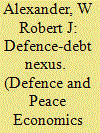| Srl | Item |
| 1 |
ID:
119265


|
|
|
|
|
| Publication |
2013.
|
| Summary/Abstract |
The literature in defence economics has tended to focus on the relationship between defence spending and economic growth. Studies examining the linkage between defence spending and government debt have been relatively rare. Given the recent Global Financial Crisis, originating in the developed economies, and the changed international security picture since 9/11, it is timely to reconsider the defence-debt nexus in the rich economies. This study pays particular attention to developing an empirical strategy which is both soundly based on economic theory concerning the evolution of public debt and which uses econometric methods that are welladapted to the dynamic aspects of the relationship. From the standpoint of economic theory, if a government seeks to minimize the distortionary costs of taxation, then taxation will follow a random walk. Unexpected shocks (war and recession) will cause debt. Other idiosyncratic national-level political considerations that affect the evolution of debt can be factored out by the use of a dynamic panel estimation method. Employing the Arellano-Bond dynamic panel model to the data available from members of the Organization for Economic Co-operation and Development and North Atlantic Treaty Organization over the periods 1988-2009 and 1999-2009, this study finds that the defence burden is a statistically significant and economically important determinant of public debt.
|
|
|
|
|
|
|
|
|
|
|
|
|
|
|
|
| 2 |
ID:
119263


|
|
|
|
|
| Publication |
2013.
|
| Summary/Abstract |
This study revisits the relationship between defence spending and economic growth via a Keynesian model in Pakistan using the autoregressive distributive lag bounds testing approach to cointegration. Empirical evidence suggests a stable cointegration relationship between defence spending and economic growth. An increase in defence spending reduces the pace of economic growth confirming the validity of Keynesian hypothesis in this case. Current economic growth is positively linked with economic growth of previous periods while a rise in non-military expenditures boosts economic growth. Interest rate is inversely associated with economic growth. Finally, unidirectional causality running from military spending to economic growth is found.
|
|
|
|
|
|
|
|
|
|
|
|
|
|
|
|
| 3 |
ID:
119267


|
|
|
|
|
| Publication |
2013.
|
| Summary/Abstract |
In a recent paper in this journal, Wijewerra and Webb study the connection between military spending and gross domestic product (GDP) in a group of five South Asian countries, finding a small but statistically significant positive relationship between military spending and GDP. This paper reviews their approach and proposes an alternative which tries to deal with the problems of omitted variables and variable construction. It finds, in contrast, that a higher share of military spending in GDP is associated with lower growth of GDP per capita.
|
|
|
|
|
|
|
|
|
|
|
|
|
|
|
|
| 4 |
ID:
119268


|
|
|
|
|
| Publication |
2013.
|
| Summary/Abstract |
We review some critical comments upon our earlier paper in this journal and respond to these. We also critically evaluate a proposed alternative methodology giving reasons why our own provides a more robust approach for examining the nexus between military spending and economic growth in South Asia.
|
|
|
|
|
|
|
|
|
|
|
|
|
|
|
|
| 5 |
ID:
119266


|
|
|
|
|
| Publication |
2013.
|
| Summary/Abstract |
This study analyses the performance of the productivity of the main industrial subsectors composing the security and defence technological and industrial base (SDTIB) in Spain from 1996 to 2009. Accordingly, we have used the non-parametric data envelopment analysis and bootstrapping techniques to compute Malmquist productivity indexes that allow us to split productivity growth into efficiency change and technical progress. The results obtained show productivity improvement in the SDTIB as a whole due mainly to advances in technology and to a lesser extent to the contribution of technical efficiency. The bootstrap approach yields further evidence, as for many cases, productivity growth or decline, is not statistically significant. This is the first time a study of this kind has been carried out on the production process of this sector in Spain.
|
|
|
|
|
|
|
|
|
|
|
|
|
|
|
|
| 6 |
ID:
119264


|
|
|
|
|
| Publication |
2013.
|
| Summary/Abstract |
This article introduces a supply-side perspective to the study of counterterrorism, where terrorists are viewed as combining terrorist attacks to achieve an aggregate output (e.g. social anxiety). With this novel approach, the elasticity of substitution, associated with the terrorists' production function, becomes a key determinant of the effectiveness of deterrence. If this elasticity is large, then countermeasures have very limited effectiveness when directed at a single mode of attack. If, in contrast, attack modes are complements, focused countermeasures can completely eliminate terrorists' gains. Counterterrorism measures are more effective when terrorist campaigns display little diversity of attacks. The article also identifies when proactive policies are more effective than defensive policies. The supply-side perspective gives a new pessimistic view to benevolence, which reduces the cost of nonterrorist activities.
|
|
|
|
|
|
|
|
|
|
|
|
|
|
|
|